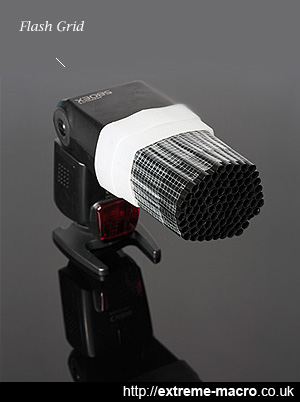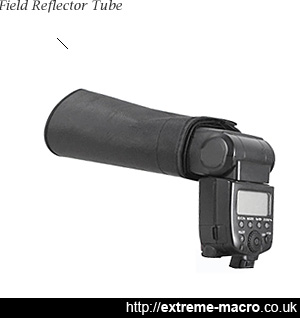Flash Grid
by Johan J Ingles-Le Nobel
Last updated August 31, 2017
A grid is actually just a series of tight snoots, so if you understand snoots you'll get the concept of a grid quite easily. Grids are used to tighten flash output even more than snoots.
Grids

Flash grid made out of - yes - straws. Grids are used to tighten flash output even more than snoots. Grids give you a very tight spot of light with nice edge gradients. The width of the beam depends on the size of the internal spaces of the grid. Blackened cardboard works well as a cheap and cheerful DIY grid. Be careful of having the grid too close to the clear perspex of the flash as the temperatures there are high and the heat needs to dissipate.
Grids give you a very tight spot of light with nice edge gradients. The width of the beam depends on the size of the internal spaces of the grid, and the thickness of the grid material itself.
Cardboard works well as a DIY grid although being brown, it will give a bit of a warming effect.
Nowadays there is also white plastic sign material available on eBay under a search such as "corrugated white plastic" that would also make a good grid.
Coroplast, the name for such corrugated white plastic sheeting in the US, is known as Correx in the UK. Finally, if all else fails, use a bunch of cut straws.
If you want a grid with a fast falloff, use a black grid material.
If you want a grid with slowest falloff, use white or even better, shiny metal.
Field Macro Grids

Field reflector tube. If you need a way to make your subject stand out using a grid will help you achieve very selective lighting. A small homemade grid or field reflector tube can give your flash a 300mm zoom setting for field macro with very little investment. Look for one with silver inside and velcro to attach round your flash. £10 from eBay ("foldable reflector").
We often need to separate our macro subject from the background, make it stand out from distracting elements in the scene. For photographers using natural light, the use of depth of field allows the isolation of the subject from the background scene, and this can be achieved by using a lens with a fast aperture. The faster the aperture, the nicer background blur you can create. Fast aperture - your lens open at f/2.8 - means you'll need a fast shutter speed.
But for photographers using flash in their work, there's a bit of a problem. You may be forced to use a small aperture when shooting outdoors due to the fact that the use of flash restrict your shutter speed to a maximum value like 1/180, which is actually a bit too slow to also use a fast aperture, even at low ISO. There's just too much damn light. The brightness of the ambience and this shutter speed means you need will need to stop down to expose the ambience properly. So you need a way to make your subject stand out.
The way to do this is to balance your ambient with use of flash, and if you really need to land the flash light on just one part of your image, using a grid will help you achieve that aim. A small homemade grid or field reflector tube can give your flash a 300mm zoom setting for field macro with very little investment.
